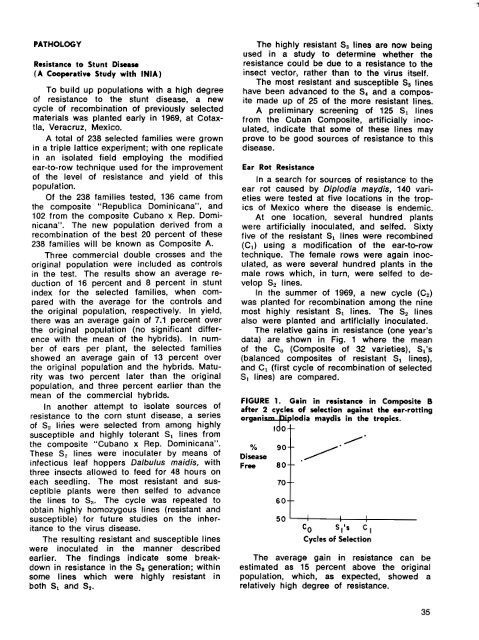REPORT - Search CIMMYT repository
REPORT - Search CIMMYT repository
REPORT - Search CIMMYT repository
Create successful ePaper yourself
Turn your PDF publications into a flip-book with our unique Google optimized e-Paper software.
PATHOLOGY<br />
Resistance to Stunt Disease<br />
(A Cooperative Study with INIA)<br />
To build up populations with a high degree<br />
of resistance to the stunt disease, a new<br />
cycle of recombination of previously selected<br />
materials was planted early in 1969, at Cotaxtla,<br />
Veracruz, Mexico.<br />
A total of 238 selected families were grown<br />
in a triple lattice experi.ment; with one replicate<br />
in an isolated field employing the modified<br />
ear-to-row technique used for the improvement<br />
of the level of resistance and yield of this<br />
population.<br />
Of the 238 families tested, 136 came from<br />
the composite "Republica Dominicana", and<br />
102 from the composite Cubano x Rep. Dominicana".<br />
The new population derived from a<br />
recombination of the best 20 percent of these<br />
238 families will be known as Composite A.<br />
Three commercial double crosses and the<br />
original population were included as controls<br />
in the test. The results show an average reduction<br />
of 16 percent and 8 percent in stunt<br />
index for the selected families, when compared<br />
with the average for the controls and<br />
the original population, respectively. In yield,<br />
there was an average gain of 7.1 percent over<br />
the original population (no significant difference<br />
with the mean of the hybrids). In number<br />
of ears per plant, the selected families<br />
showed an average gain of 13 percent over<br />
the original population and the hybrids. Maturity<br />
was two percent later than the original<br />
population, and three percent earlier than the<br />
mean of the commercial hybrids.<br />
In another attempt to isolate sources of<br />
resistance to the corn stunt disease, a series<br />
of 8Q lines were selected from among highly<br />
susc~ptible and highly toLerant 8 1 lines from<br />
the composite "Cubano x Rep. Dominicana",<br />
These 8:! lines were inoculater by means of<br />
infectious leaf hoppers Dalbulus maidis, with<br />
three insects allowed to feed for 48 hours on<br />
each seedling. The most resistant and susceptible<br />
plants were then selfed to advance<br />
the lines to 8;j. The cycle was repeated to<br />
obtain highly homozygous lines (resistant and<br />
susceptible) for future studies on the inheritance<br />
to the virus disease.<br />
The resulting resistant and susceptible lines<br />
were inoculated in the manner described<br />
earlier. The findings indicate some breakdown<br />
in resistance in the 8 3 generation; within<br />
some lines which were highly resistant in<br />
both 8 1 and 8 2 ,<br />
The highly resistant 8 3 Jines are now being<br />
used in a study to determine whether the<br />
resistance could be due to a resistance to the<br />
insect vector, rather than to the virus itself.<br />
The most resistant and susceptible 8 3 lines<br />
have been advanced to the 8. and a composite<br />
made up of 25 of the more resistant lines.<br />
A preliminary screening of 125 8 1 ' lines<br />
from the Cuban Composite, artificially inoculated,<br />
indicate that some of these lines may<br />
prove to be good sources of resistance to this<br />
disease.<br />
Ear Rot Resistance<br />
In a search for sources of resistance to the<br />
ear rot caused by Diplodia maydis, 140 varieties<br />
were tested at five locations in the tropics<br />
of Mexico where the disease is endemic.<br />
At one location, several hundred plants<br />
were artificially inoculated, and selfed. 8ixty<br />
five of the resistant 8 1 lines were recombined<br />
(C 1 ) using a modification of the ear-te-row<br />
technique. The female rows were again inoculated,<br />
as were several hundred plants in the<br />
male rows which, in turn, were selfed to develop<br />
8 2 lines.<br />
In the summer of 1969, a new cycle (C 2 )<br />
was planted for recombination among the nine<br />
most highly resistant 8 1 lines. The 8 2 lines<br />
also were planted and artificially inoculated.<br />
The relative gains in resistance (one year's<br />
data) are shown in Fig. 1 where the mean<br />
of the Co (Composite of 32 varieties), 8 1 's<br />
(balanced composites of resistant 8 1 lines),<br />
and C 1 (first cycle of recombination of selected<br />
8 1 lines) are compared.<br />
%<br />
Disease<br />
Free<br />
90<br />
80<br />
70<br />
60<br />
50 ~---t----+--I------<br />
Co s,'s C 1<br />
Cycles of Selection<br />
The average gain in resistance can be<br />
estimated as 15 percent above the original<br />
popUlation, which, as expected, showed a<br />
relatively high degree of resistance.<br />
35

















